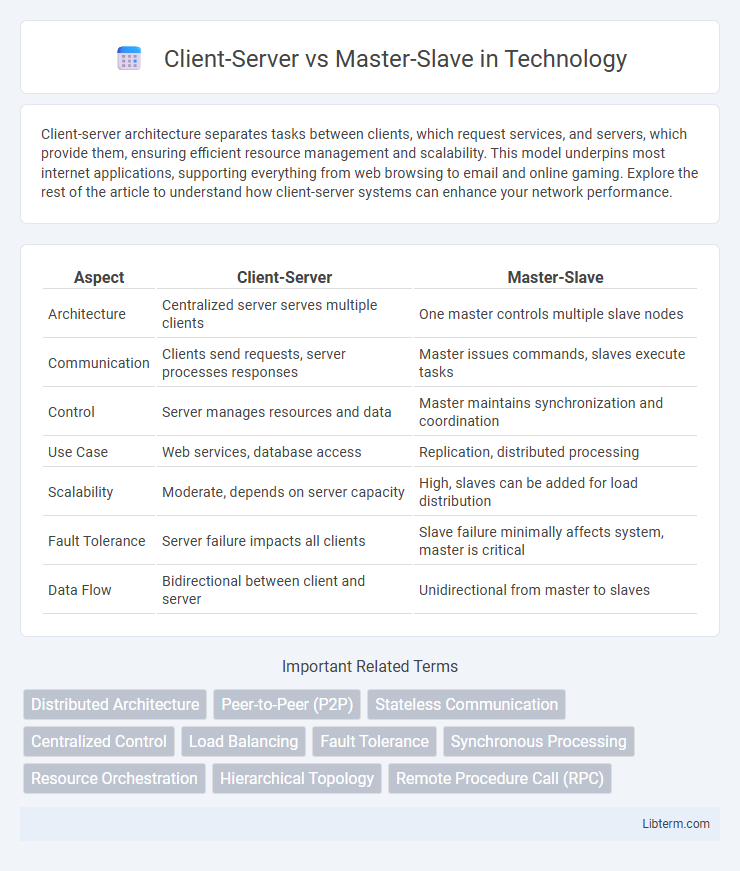Client-server architecture separates tasks between clients, which request services, and servers, which provide them, ensuring efficient resource management and scalability. This model underpins most internet applications, supporting everything from web browsing to email and online gaming. Explore the rest of the article to understand how client-server systems can enhance your network performance.
Table of Comparison
| Aspect | Client-Server | Master-Slave |
|---|---|---|
| Architecture | Centralized server serves multiple clients | One master controls multiple slave nodes |
| Communication | Clients send requests, server processes responses | Master issues commands, slaves execute tasks |
| Control | Server manages resources and data | Master maintains synchronization and coordination |
| Use Case | Web services, database access | Replication, distributed processing |
| Scalability | Moderate, depends on server capacity | High, slaves can be added for load distribution |
| Fault Tolerance | Server failure impacts all clients | Slave failure minimally affects system, master is critical |
| Data Flow | Bidirectional between client and server | Unidirectional from master to slaves |
Introduction to Client-Server and Master-Slave Architectures
Client-server architecture organizes distributed systems by dividing roles between service providers (servers) and requesters (clients), optimizing resource management and scalability. Master-slave architecture designates one node as the master controlling one or multiple slave nodes, ensuring synchronized data replication and task coordination. Both architectures support communication and processing in distributed networks but differ in control hierarchy and interaction flow.
Core Principles of Client-Server Model
The Client-Server model operates on a clear division of roles where clients request resources or services, and servers provide responses, facilitating centralized control and resource management. Core principles include request-response communication, scalability through multiple clients connecting to a single server, and maintaining server-side data consistency and security. This architecture supports efficient resource sharing and networked application deployment by optimizing interactions between distributed clients and centralized servers.
Key Features of Master-Slave Architecture
Master-Slave architecture features a central master node that controls and coordinates multiple slave nodes, ensuring data consistency and task distribution. Slaves perform specific tasks or data processing under the master's command, enabling parallelism and fault tolerance. This architecture is commonly used in databases and distributed systems to improve reliability and scalability.
Communication Patterns: Client-Server vs Master-Slave
Client-server communication involves clients sending requests to a central server that processes and returns responses, enabling bidirectional interaction and dynamic task allocation. Master-slave communication features a master node that controls and directs slave nodes, which perform tasks without initiating communication or requesting data independently. This unidirectional control pattern in master-slave systems contrasts with the more flexible, request-driven exchanges found in client-server architectures.
Scalability Comparison
Client-server architecture offers higher scalability by allowing multiple clients to connect to and interact with a centralized server, enabling the system to handle increased loads by upgrading the server or distributing client requests. Master-slave architecture typically faces scalability limitations due to its rigid hierarchy where the master node controls multiple slave nodes, creating bottlenecks as the number of slaves increases and requiring complex synchronization. Scalability in client-server systems is enhanced through load balancing and distributed servers, while master-slave setups often depend on vertical scaling and risk performance degradation under heavy workloads.
Fault Tolerance and Reliability
Client-Server architecture centralizes control in the server, making fault tolerance dependent on server redundancy and failover mechanisms to maintain reliability. Master-Slave systems distribute workload across nodes, with the master managing coordination and slaves handling tasks, enhancing fault tolerance by enabling slaves to take over or continue operations if the master fails. Reliability in Master-Slave setups improves through replication and synchronization protocols, ensuring data consistency and system availability during faults.
Security Considerations
Client-server architecture centralizes authentication and authorization processes, enabling robust security measures such as encrypted communication channels and granular access controls tailored for individual clients. Master-slave configurations often face risks with elevated privileges on the master node, making it a high-value target for attacks that could compromise the entire replication or control process. Ensuring role-based access, secure replication protocols, and frequent security audits are critical to mitigating vulnerabilities inherent in both models.
Real-World Examples and Use Cases
Client-server architecture powers everyday applications such as email services, web browsing, and online banking where clients request resources and servers respond, ensuring efficient data exchange and resource management. Master-slave configurations are prevalent in database replication systems like MySQL and Redis, where the master handles write operations and propagates changes to slave nodes for read scalability and redundancy. Both models optimize different scenarios: client-server suits interactive applications with multiple users, while master-slave excels in high-availability and load-distributed environments.
Advantages and Disadvantages
Client-Server architecture offers centralized control, improved security, and easier maintenance but can face bottlenecks and single points of failure. Master-Slave systems allow for workload distribution, enhanced data redundancy, and fault tolerance while potentially causing latency issues and complexity in synchronization. Choosing between them depends on scalability needs, consistency requirements, and fault-tolerance priorities.
Choosing the Right Architecture for Your Application
Choosing the right architecture for your application depends on factors like scalability, control, and communication patterns. Client-server architecture excels in environments requiring centralized control and independent client interactions, while master-slave architecture is ideal for scenarios demanding strict synchronization and task delegation across nodes. Evaluating workload distribution and fault tolerance needs ensures optimal performance and resource management in your system design.
Client-Server Infographic

 libterm.com
libterm.com